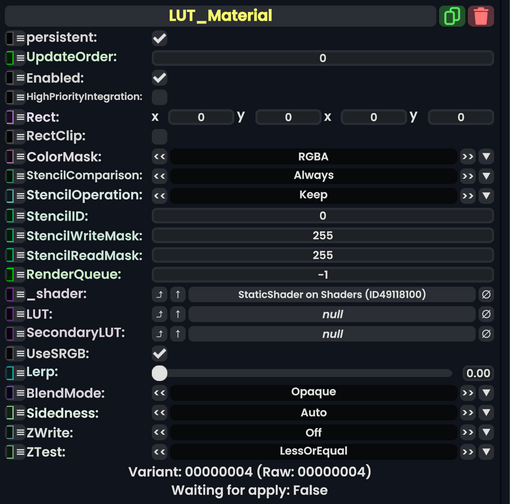
An LUT or Lookup Table is a way of mapping input values to output values via sampling a 3D Texture. This 3D table of values allows for any arbitrary function to be applied to an input.
How the sampling works is that it takes a color behind it (for example, a magenta color) and maps it's RGB values to a 0-1 Float3 as XYZ, it then samples the provided 3D texture at point XYZ multipled by the texture's size, and uses the pixel's color as the result which is applied to what the user sees through this material.
For more info on how pixels are arranged on a 3D texture and can be retrieved using an Int3, see 3D Texture.
Fields
| Name | Type | Description |
|---|---|---|
persistent
|
Bool | Determines whether or not this item will be saved to the server. |
UpdateOrder
|
Int | Controls the order in which this component is updated. |
Enabled
|
Bool | Controls whether or not this component is enabled. Some components stop their functionality when this field is disabled, but some don't. |
HighPriorityIntegration
|
Bool | If true, integrating this asset (e.g. processing procedural assets) gets higher priority than assets with this flag off. An example is user laser procedural meshes. |
Rect
|
Rect | |
RectClip
|
Bool | |
ColorMask
|
ColorMask | The color channels to affect |
StencilComparison
|
StencilComparison | |
StencilOperation
|
StencilOperation | |
StencilID
|
Byte | |
StencilWriteMask
|
Byte | |
StencilReadMask
|
Byte | |
RenderQueue
|
Int | |
_shader
|
Shader | Internal. |
LUT
|
Texture3D | The 3D texture to use as a lookup table |
SecondaryLUT
|
Texture3D | A secondary 3D texture to use to lerp between |
UseSRGB
|
Bool | |
Lerp
|
Float | Allows blending from the first LUT (0) or the secondary LUT (1) |
BlendMode
|
BlendMode | |
Sidedness
|
Sidedness | |
ZWrite
|
ZWrite | |
ZTest
|
ZTest |
Usage
The mapping function of an LUT takes an input RGB value and then samples the 3D Texture at that corresponding coordinate to find the output RGB value, using the 3D Texture's Filter Mode and Wrap Mode to resolve how intermediate values work.